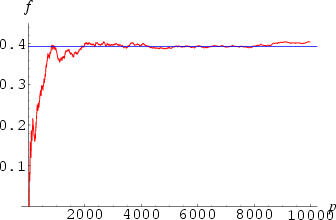In a 1847 talk to the Académie des Sciences in Paris, Gabriel Lamé ![]() (1795-1870) claimed to have proven Fermat's last theorem. However, Joseph Liouville
(1795-1870) claimed to have proven Fermat's last theorem. However, Joseph Liouville ![]() immediately pointed out an error in Lamé's result by pointing out that Lamé had incorrectly assumed unique factorization in the ring of p-cyclotomic integers. However, Kummer
immediately pointed out an error in Lamé's result by pointing out that Lamé had incorrectly assumed unique factorization in the ring of p-cyclotomic integers. However, Kummer ![]() had already studied the failure of unique factorization in cyclotomic fields and subsequently formulated a theory of ideals which was later further developed by Dedekind.
had already studied the failure of unique factorization in cyclotomic fields and subsequently formulated a theory of ideals which was later further developed by Dedekind. ![]()
Kummer was able to prove Fermat's last theorem for all prime exponents falling into a class he called "regular." "Irregular" primes are thus primes that are not a member of this class, and a prime p is irregular iff p divides the class number of the cyclotomic field generated by ![]() .
.![]() with
with ![]() (Broadhurst).
(Broadhurst).

An infinite number of irregular primes exist, as proven in 1915 by Jensen (Vandiver and Wahlin 1928, p. 82; Carlitz 1954; Carlitz 1968). In fact, Jensen also proved the slightly stronger result that there are an infinite number of irregular primes congruent to 5 (mod 6) (Carlitz 1968), a result subsequently improved by Montgomery (1965). The first few irregular primes are 37, 59, 67, 101, 103, 131, 149, 157, ... (Sloane's A000928). Of the ![]() primes less than
primes less than ![]() ,
,![]() (or 39.41%) are irregular. The conjectured fraction is
(or 39.41%) are irregular. The conjectured fraction is ![]() (Ribenboim 1996, p. 415).
(Ribenboim 1996, p. 415).
The numbers of irregular primes less than ![]() for n = 0, 1, 2, ... are 0, 0, 3, 64, 497, ... (Sloane's A092901).
for n = 0, 1, 2, ... are 0, 0, 3, 64, 497, ... (Sloane's A092901).
The largest known irregular prime is ![]() ,
,
![]()
Bernoulli Number, Fermat's Last Theorem, Integer Sequence Primes, Irregular Pair, Regular Prime
![]()
![]()
Buhler, J.; Crandall, R.; Ernvall, R.; and Metsänkylä, T. "Irregular Primes and Cyclotomic Invariants to Four Million." Math. Comput. 61, 151-153, 1993.
Buhler, J.; Crandall, R.; Ernvall, R.; Metsankyla, T.; and Shokrollahi, M. "Irregular Primes and Cyclotomic Invariants to 12 Million." J. Symb. Comput. 11, 1-8, 2000.
Buhler, J. P.; Crandall, R. E.; and Sompolski, R. W. "Irregular Primes to One Million." Math. Comput. 59, 717-722, 1992.
Caldwell, C. K. "The Prime Pages. The Top 20: irregular Primes." http://primes.utm.edu/top20/page.php?id=26.
Carlitz, L. "A Note on Irregular Primes." Proc. Amer. Math. Soc. 5, 329-331, 1954.
Carlitz, L. " Bernoulli Numbers." Fib. Quart. 6, 71-85, 1968.
Hardy, G. H. and Wright, E. M. An Introduction to the Theory of Numbers, 5th ed. Oxford, England: Clarendon Press, p. 202, 1979.
Havil, J. Gamma: Exploring Euler's Constant. Princeton, NJ: Princeton University Press, p. 85, 2003.
Hoffman, P. The Man Who Loved Only Numbers: The Story of Paul Erdos and the Search for Mathematical Truth. New York: Hyperion, p. 192, 1998.
Johnson, W. "Irregular Primes and Cyclotomic Invariants." Math. Comput. 29, 113-120, 1975.
Johnson, W. "Irregular Prime Divisors of the Bernoulli Numbers." Math. Comput. 28, 653-657, 1974.
Montgomery, H. L. "Distribution of Irregular Primes." Ill. J. Math. 9, 553-558, 1965.
Ribenboim, P. The New Book of Prime Number Records. New York: Springer-Verlag, pp. 325-329 and 414-425, 1996.
Siegel, C. L. "Zu zwei Bemerkungen Kummers." Nachr. Akad. d. Wiss. Göttingen, Math. Phys. KI. 2, 51-62, 1964.
Sloane, N. J. A. Sequences A000928/M5260 and A092901 in "The On-Line Encyclopedia of Integer Sequences." http://www.research.att.com/~njas/sequences/.
Stewart, C. L. "A Note on the Fermat Equation." Mathematika 24, 130-132, 1977.
Vandiver, H. S. "On Developments in an Arithmetic Theory of the Bernoulli and Allied Numbers." Scripta Math. 25, 273-303, 1960.
Vandiver, H. S. and Wahlin, G. E. "Algebraic Numbers." Bull. Nat. Res. Council., No. 62, 1928.
Wagstaff, S. S. Jr. "The Irregular Primes to 125000." Math. Comput. 32, 583-591, 1978.
![]()